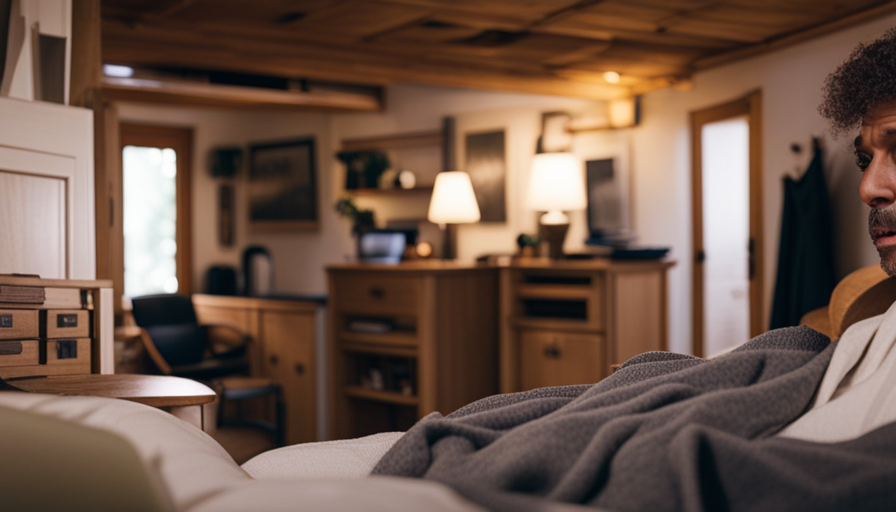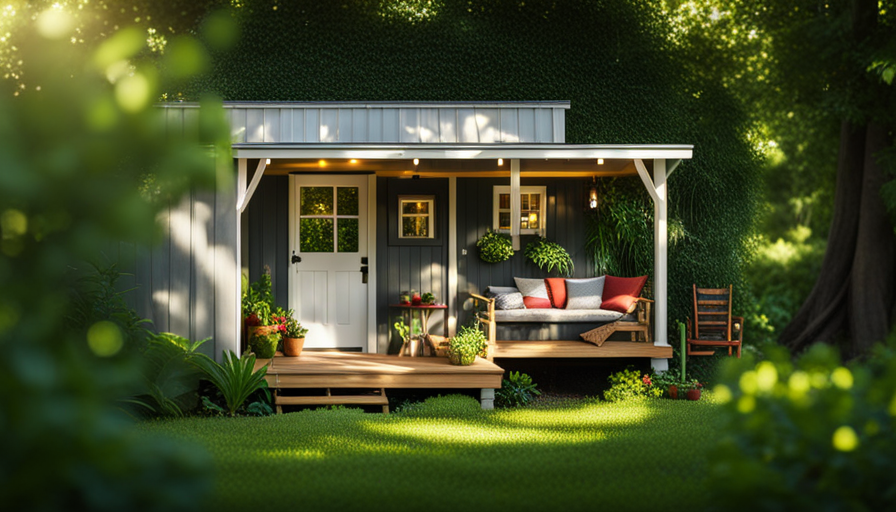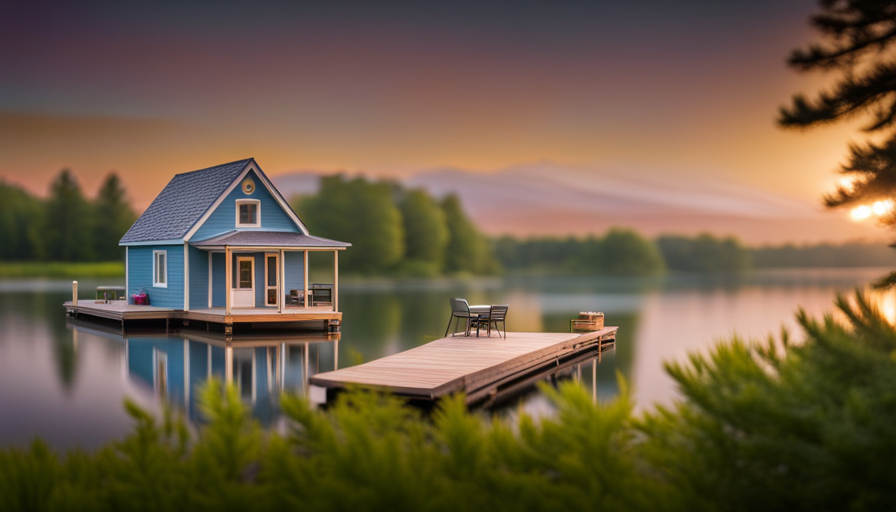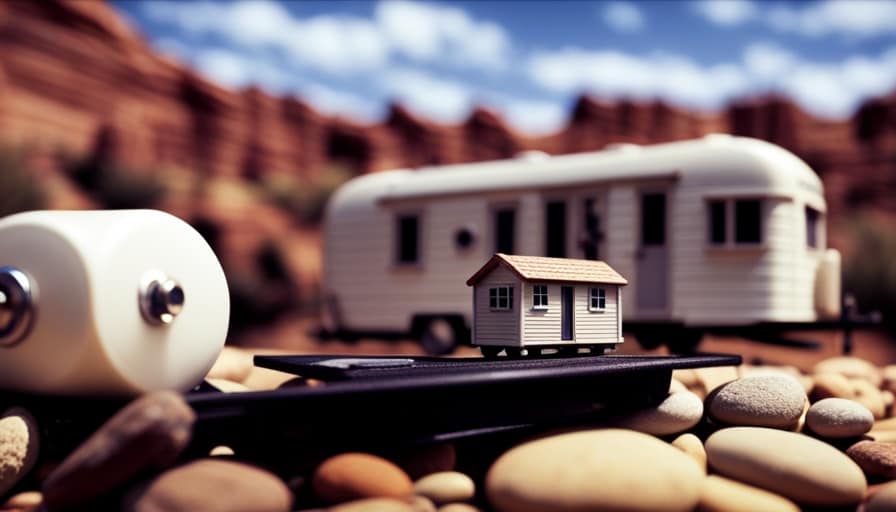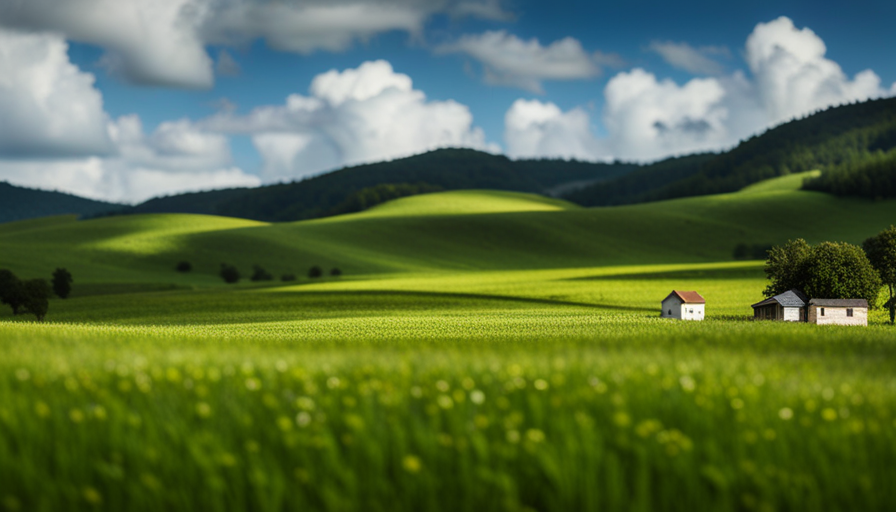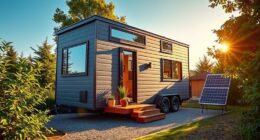Living in a tiny home can sometimes feel like navigating a crowded maze, with challenges lurking at every turn. Embracing this lifestyle requires strength, adaptability, and a willingness to embrace simplicity. However, before embarking on this unique journey, it’s important to acknowledge the potential obstacles that may arise. These obstacles can be likened to dark clouds looming on the horizon, threatening to cast a shadow over your tiny house experience.
From limited space and storage options to zoning restrictions and building codes, each obstacle presents its own set of hurdles. Lack of privacy and personal space, difficulty in finding suitable land and parking, and limited amenities and utilities can also make tiny living feel like a constant battle.
Add to that the challenges of downsizing and decluttering, potential issues with financing and insurance, limited resale value and market demand, and maintenance and upkeep challenges, and it becomes clear that tiny house living is not for the faint of heart.
In this article, we will delve into each barrier, providing practical tips and solutions to help you navigate the stormy seas of tiny house living.
Key Takeaways
- Zoning restrictions and building codes can pose challenges when it comes to finding suitable land and parking for a tiny house.
- Limited amenities and utilities, such as access to reliable electricity and water sources, can impact daily life in a tiny house, requiring alternative energy sources like solar panels and generators.
- Financing and insurance for tiny houses can be challenging due to their size and mobility, making it difficult to obtain loans and find suitable insurance coverage.
- Maintenance and upkeep responsibilities are higher in a tiny house, with limited space making repairs more difficult and space optimization crucial. Regular cleaning and decluttering are necessary to keep the tiny house functional and comfortable.
Limited Space and Storage Options
You’ll quickly realize that in a tiny house, your stuff is going to have to get cozy and creative with limited space and storage options. Living in a small space requires some smart thinking and small living solutions to make the most of every inch.
One of the first things you’ll need to do is prioritize your belongings. You’ll have to evaluate what you truly need and what can be donated or stored elsewhere.
Once you’ve sorted through your belongings, it’s time to get creative with organization. Look for furniture that has built-in storage, like ottomans with hidden compartments or bed frames with drawers underneath. Utilize vertical space by installing shelves or hooks on the walls to store items like kitchen utensils or clothing. Maximize the space under beds and sofas with storage bins or vacuum-sealed bags.
Another clever idea is to use multi-functional furniture, like a coffee table that can also serve as a dining table. By thinking outside the box and utilizing creative organization, you can make the most of your limited space.
Now let’s move on to zoning restrictions and building codes, which are important considerations when living in a tiny house.
Zoning Restrictions and Building Codes
Navigating zoning restrictions and building codes can pose significant challenges when it comes to setting up your cozy abode in a compact space. Zoning regulations dictate how a property can be used and can vary greatly from one area to another. These regulations may limit the size, location, and even the type of tiny house you can build. It’s important to research and understand the specific zoning regulations in your area before embarking on your tiny house journey.
In addition to zoning restrictions, building codes also play a crucial role in the construction of a tiny house. These codes ensure that the structure is safe and meets certain standards. However, complying with building codes can be tricky when working with limited space. It may require creative solutions and careful planning to meet all the necessary requirements.
To better understand the complexities of zoning restrictions and building codes, let’s take a look at the following table:
| Zoning Regulations | Construction Permits |
|---|---|
| Limitations on size | Permits for foundation |
| Restrictions on location | Permits for utilities |
| Requirements for type of structure | Permits for electrical |
| Setback requirements | Permits for plumbing |
| Parking regulations | Permits for structural changes |
As you can see, there are various aspects to consider when it comes to compliance with zoning regulations and building codes. These factors can greatly impact the design and construction process of your tiny house.
Moving on to the next section about lack of privacy and personal space, it’s important to address the challenges that arise from living in close quarters with limited room for personal retreat.
Lack of Privacy and Personal Space
Living in a compact space can sometimes feel like being a sardine in a can, with limited room for personal retreat and privacy. One of the biggest challenges of living in a tiny house is the lack of privacy and personal space. Privacy concerns are a common issue when it comes to tiny house living.
With limited square footage, it can be challenging to find a secluded spot where you can have some alone time. The close proximity to others can make it difficult to escape the constant noise and activity that comes with communal living.
However, there are ways to address these privacy concerns and make your tiny house feel more personal and private. One option is to utilize curtains or room dividers to create separate spaces within your tiny house. This can help create a sense of privacy and define different areas for different activities. Additionally, you can personalize your tiny house to make it feel more like your own private sanctuary. Adding personal touches, such as artwork, plants, or sentimental items, can help create a sense of individuality and make your tiny house feel more like home.
Despite the challenges, living in a tiny house can be a rewarding experience. However, it’s important to consider the lack of privacy and personal space when deciding if this lifestyle is right for you.
In the next section, we will explore the difficulty in finding suitable land and parking for tiny houses without compromising on privacy and personal space.
Difficulty in Finding Suitable Land and Parking
Finding suitable land and parking for your tiny house can be a challenging endeavor, as it requires careful consideration and research to ensure privacy and personal space are not compromised. One of the biggest hurdles is finding suitable communities that allow tiny houses.
Many cities and towns have zoning restrictions that prohibit or limit the placement of tiny houses. It’s important to do thorough research and reach out to local authorities to determine if there are any specific regulations or requirements for parking a tiny house.
Another factor to consider is the cost of land and parking. Depending on the area, finding affordable land can be a challenge. Additionally, some communities may require you to pay monthly fees for parking your tiny house on their property. It’s essential to factor in these costs when budgeting for your tiny house lifestyle.
Transitioning into the next section about limited amenities and utilities, it’s important to note that finding suitable land and parking is just the beginning. Once you have secured a location, you may face challenges in accessing basic amenities such as water, electricity, and sewage. These limitations can further impact your daily life in a tiny house, and we’ll explore them in the following section.
Limited Amenities and Utilities
Once you secure a location for your tiny house, you’ll quickly realize that limited amenities and utilities can become a significant challenge, impacting your daily life.
Did you know that nearly 25% of tiny house owners struggle with accessing reliable electricity and water sources, which can greatly affect their overall comfort and convenience? Living off the grid presents unique challenges, as you may need to rely on alternative energy sources such as solar panels or generators for electricity. Additionally, finding a consistent and clean water source can be a constant struggle. These limitations can significantly impact your mental well-being, as the lack of basic amenities can lead to feelings of frustration and isolation.
Limited amenities and utilities can greatly impact your daily routine. Without access to a reliable power source, you may have to carefully manage your energy usage to ensure you have enough to power essential appliances. This can mean limiting the use of heating or cooling systems, refrigeration, or even charging electronic devices. Furthermore, the absence of basic utilities like running water can make simple tasks like cooking, cleaning, and personal hygiene more challenging. These challenges of off-grid living can take a toll on your mental well-being, as it requires constant adaptation and problem-solving.
Transitioning to the next section about ‘social stigma and misconceptions,’ it’s important to understand that these challenges are not insurmountable. While limited amenities and utilities can be difficult, they can also foster a sense of self-reliance and resourcefulness. By understanding and addressing these challenges, you can create a fulfilling and sustainable lifestyle in your tiny house, debunking the misconceptions and social stigma associated with this alternative way of living.
Social Stigma and Misconceptions
Despite the challenges, embracing a tiny house lifestyle allows individuals to break free from societal norms and shatter misconceptions about what constitutes a fulfilling and sustainable living experience.
One of the biggest barriers faced when living in a tiny house is the social stigma and misconceptions surrounding this alternative way of living. Many people still associate success and happiness with owning a large house and possessing material possessions. This can lead to a lack of social acceptance and judgment from others when choosing to live in a tiny house.
However, by making lifestyle adjustments and adopting a minimalist mindset, individuals can overcome these challenges. It’s important to educate others about the benefits of living in a tiny house, such as reduced environmental impact, financial freedom, and increased flexibility. By sharing personal experiences and showcasing the creative use of space in a tiny home, we can challenge the misconceptions and inspire others to consider this lifestyle.
Transitioning into the subsequent section about challenges in downsizing and decluttering, it is crucial to acknowledge that embracing a tiny house lifestyle is not without its difficulties.
Challenges in Downsizing and Decluttering
Living in a tiny house often means embracing a minimalist lifestyle, which requires downsizing and decluttering. This can be a significant challenge for many people, myself included. Transitioning from a larger space to a tiny house means making tough decisions about what to keep and what to let go of. It’s not just about getting rid of physical belongings; it’s also about letting go of emotional attachments.
Letting go of sentimental items can be particularly difficult. We tend to attach memories and emotions to certain objects, making it hard to part with them. However, in a tiny house, every inch of space is precious, and we must prioritize functionality over sentimentality. It’s a process that requires careful consideration and a willingness to let go.
Downsizing and decluttering can also be a practical challenge. It involves deciding what items are truly essential and necessary for everyday life. It requires us to reevaluate our needs and wants, and sometimes make sacrifices. However, it can also be a liberating experience, as it allows us to simplify our lives and focus on what truly matters.
As we move forward in this journey, it’s important to acknowledge that challenges in downsizing and decluttering are just the beginning. The next section will explore potential issues with financing and insurance, which are crucial aspects to consider when embarking on the tiny house lifestyle.
Potential Issues with Financing and Insurance
When it comes to financing and insurance for your compact abode, you may find yourself facing some potential hurdles along the way. Let’s start with the financing challenges. Traditional lenders may be hesitant to provide loans for tiny houses due to their unconventional nature. They often require a minimum loan amount, which may be higher than the cost of a tiny house. Additionally, the lack of a permanent foundation and the mobility of tiny houses can raise concerns for lenders. This means you may need to explore alternative financing options such as personal loans or RV loans.
Now, let’s talk about insurance requirements. Insuring a tiny house can be a bit tricky. Some insurance companies may not offer coverage for tiny houses, considering them high risk due to their size and mobility. Finding an insurance policy that specifically caters to tiny houses might be a challenge. You may need to do some research to find specialized insurance companies or explore options like adding your tiny house to an existing homeowner’s policy.
Overall, navigating the world of financing and insurance for your tiny house may require some extra effort and research. However, with the right information and perseverance, you can find solutions that meet your needs. Moving forward, we will discuss the limited resale value and market demand for tiny houses.
Limited Resale Value and Market Demand
Navigating the world of buying and selling compact homes can be challenging due to the limited resale value and fluctuating market demand. When it comes to tiny houses, resale value concerns are a common issue. While these homes may be trendy and attractive to a niche market, they may not appeal to the broader population. This limited market appeal can result in a lower demand and ultimately lower resale value.
Additionally, the tiny house movement is still relatively new, which means that the market for these homes is not as well-established as the market for traditional houses. This lack of market demand can make it difficult to find buyers when you decide to sell your tiny house.
When considering the limited resale value and market demand of tiny houses, it is important to carefully consider your financial investment. While living in a tiny house can offer financial benefits, such as lower utility bills and reduced maintenance costs, it is crucial to weigh these advantages against the potential challenges of selling your home in the future. By being aware of these concerns, you can make an informed decision about whether a tiny house is the right choice for you.
Transitioning into the next section about maintenance and upkeep challenges, it is important to address how these factors can further impact the overall experience of living in a tiny house.
Maintenance and Upkeep Challenges
One of the challenges in maintaining and caring for a compact home is the potential for increased maintenance costs and upkeep responsibilities. Living in a tiny house means having limited space, and this can lead to more wear and tear on the few surfaces and fixtures that are there.
Here are four maintenance and upkeep challenges that I’ve experienced in my tiny house:
-
Limited space for repairs: With limited space, it can be difficult to access and repair certain areas of the house. This can make simple repairs more time-consuming and costly.
-
Higher maintenance costs: The compact size of a tiny house means that every square inch needs to be well-maintained. This can result in higher maintenance costs, as specialized equipment or materials may be needed for certain repairs.
-
Space optimization: In a tiny house, every inch of space is valuable. This means that proper organization and storage solutions are crucial. However, finding the right storage solutions that fit the limited space can be a challenge.
-
Regular cleaning and decluttering: Living in a small space requires regular cleaning and decluttering to keep the house tidy and functional. This can take up a significant amount of time and effort.
Overall, while living in a tiny house has its advantages, it also comes with its fair share of maintenance and upkeep challenges. Being aware of these challenges and taking proactive steps to address them can help ensure that your tiny house remains a comfortable and functional home.
Frequently Asked Questions
How do tiny house owners deal with limited space and storage options?
Living in a tiny house can be challenging, but I’ve found some great storage solutions to maximize space. By using clever organizational tools and furniture with built-in storage, I’ve been able to make the most of every inch.
What are some common zoning restrictions and building codes that can affect tiny house living?
Common zoning restrictions and building codes can greatly impact tiny house living. Some common restrictions include minimum square footage requirements, restrictions on permanent dwellings, and regulations on where and how tiny houses can be placed. It is important to research and understand these restrictions before embarking on tiny house living.
How do tiny house owners cope with the lack of privacy and personal space?
To manage the lack of privacy and personal space in a tiny house, I’ve learned to embrace the adage "good fences make good neighbors." I use creative privacy solutions like curtains, screens, and room dividers, while maximizing personal space through smart storage and organization techniques.
What are the challenges faced by tiny house owners when it comes to finding suitable land and parking?
Finding affordable land can be challenging for tiny house owners. It requires extensive research and negotiation skills. Additionally, dealing with parking restrictions is a constant struggle, as many areas have zoning regulations that prohibit living in a tiny house on wheels.
What are the limitations in terms of amenities and utilities that come with living in a tiny house?
Living in a tiny house has limitations in terms of amenities and utilities. However, design solutions and adaptation strategies can help maximize space and efficiency. From multipurpose furniture to off-grid systems, there are practical options available.
Conclusion
In conclusion, living in a tiny house can come with its fair share of challenges. From limited space and storage options to zoning restrictions and building codes, there are several barriers that one may face.
Additionally, the lack of privacy and personal space, as well as the difficulty in finding suitable land and parking, can make tiny house living a bit more challenging.
It’s important to consider these factors before embarking on a tiny house lifestyle. However, with careful planning and organization, these barriers can be overcome, allowing for a practical and fulfilling living experience. Remember, Rome wasn’t built in a day, and neither is the perfect tiny house!
Hi, I’m Emma. I’m the Editor in Chief of Tiny House 43, a blog all about tiny houses. While tree houses are often associated with childhood, they can be the perfect adult retreat. They offer a cozy space to relax and unwind, surrounded by nature. And since they’re typically built on stilts or raised platforms, they offer stunning views that traditional homes simply can’t match. If you’re looking for a unique and romantic getaway, a tree house tiny house might just be the perfect option.
